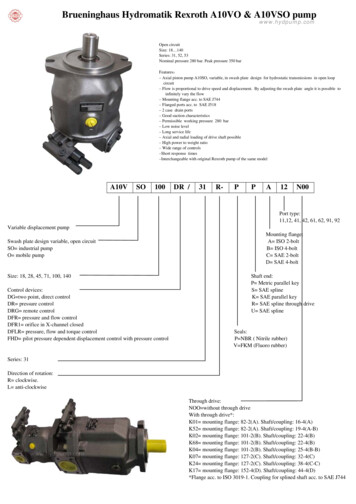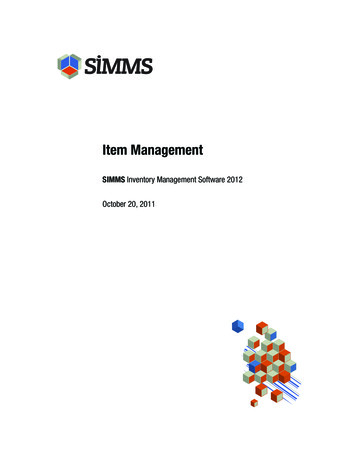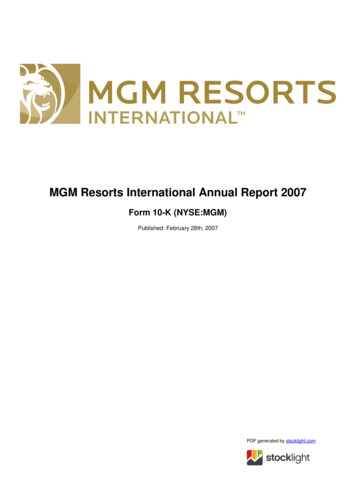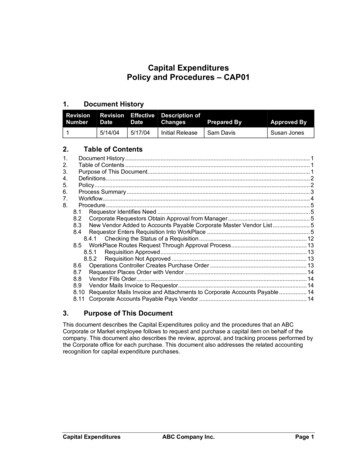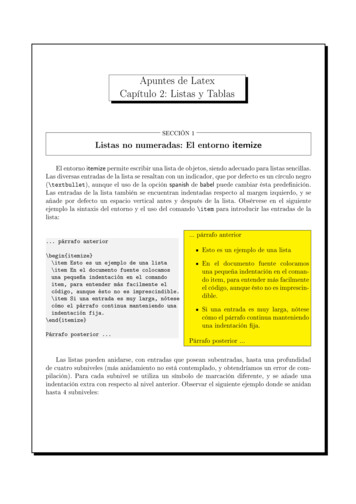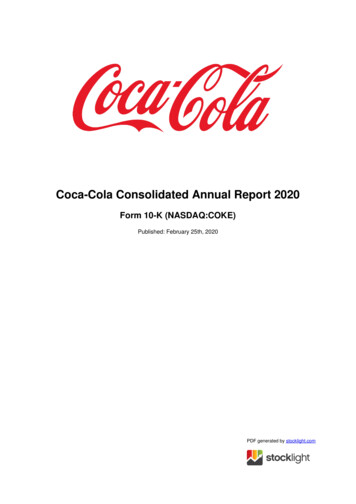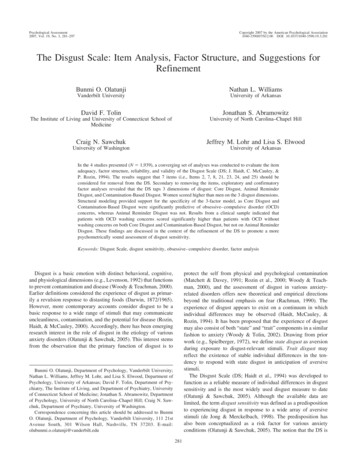
Transcription
Psychological Assessment2007, Vol. 19, No. 3, 281–297Copyright 2007 by the American Psychological Association1040-3590/07/ 12.00 DOI: 10.1037/1040-3590.19.3.281The Disgust Scale: Item Analysis, Factor Structure, and Suggestions forRefinementBunmi O. OlatunjiNathan L. WilliamsVanderbilt UniversityUniversity of ArkansasDavid F. TolinJonathan S. AbramowitzThe Institute of Living and University of Connecticut School ofMedicineUniversity of North Carolina–Chapel HillCraig N. SawchukJeffrey M. Lohr and Lisa S. ElwoodUniversity of WashingtonUniversity of ArkansasIn the 4 studies presented (N 1,939), a converging set of analyses was conducted to evaluate the itemadequacy, factor structure, reliability, and validity of the Disgust Scale (DS; J. Haidt, C. McCauley, &P. Rozin, 1994). The results suggest that 7 items (i.e., Items 2, 7, 8, 21, 23, 24, and 25) should beconsidered for removal from the DS. Secondary to removing the items, exploratory and confirmatoryfactor analyses revealed that the DS taps 3 dimensions of disgust: Core Disgust, Animal ReminderDisgust, and Contamination-Based Disgust. Women scored higher than men on the 3 disgust dimensions.Structural modeling provided support for the specificity of the 3-factor model, as Core Disgust andContamination-Based Disgust were significantly predictive of obsessive– compulsive disorder (OCD)concerns, whereas Animal Reminder Disgust was not. Results from a clinical sample indicated thatpatients with OCD washing concerns scored significantly higher than patients with OCD withoutwashing concerns on both Core Disgust and Contamination-Based Disgust, but not on Animal ReminderDisgust. These findings are discussed in the context of the refinement of the DS to promote a morepsychometrically sound assessment of disgust sensitivity.Keywords: Disgust Scale, disgust sensitivity, obsessive– compulsive disorder, factor analysisprotect the self from physical and psychological contamination(Matchett & Davey, 1991; Rozin et al., 2000; Woody & Teachman, 2000), and the assessment of disgust in various anxietyrelated disorders offers new theoretical and empirical directionsbeyond the traditional emphasis on fear (Rachman, 1990). Theexperience of disgust appears to exist on a continuum in whichindividual differences may be observed (Haidt, McCauley, &Rozin, 1994). It has been proposed that the experience of disgustmay also consist of both “state” and “trait” components in a similarfashion to anxiety (Woody & Tolin, 2002). Drawing from priorwork (e.g., Spielberger, 1972), we define state disgust as aversionduring exposure to disgust-relevant stimuli. Trait disgust mayreflect the existence of stable individual differences in the tendency to respond with state disgust in anticipation of aversivestimuli.The Disgust Scale (DS; Haidt et al., 1994) was developed tofunction as a reliable measure of individual differences in disgustsensitivity and is the most widely used disgust measure to date(Olatunji & Sawchuk, 2005). Although the available data arelimited, the term disgust sensitivity was defined as a predispositionto experiencing disgust in response to a wide array of aversivestimuli (de Jong & Merckelbach, 1998). The predisposition hasalso been conceptualized as a risk factor for various anxietyconditions (Olatunji & Sawchuk, 2005). The notion that the DS isDisgust is a basic emotion with distinct behavioral, cognitive,and physiological dimensions (e.g., Levenson, 1992) that functionsto prevent contamination and disease (Woody & Teachman, 2000).Earlier definitions considered the experience of disgust as primarily a revulsion response to distasting foods (Darwin, 1872/1965).However, more contemporary accounts consider disgust to be abasic response to a wide range of stimuli that may communicateuncleanliness, contamination, and the potential for disease (Rozin,Haidt, & McCauley, 2000). Accordingly, there has been emergingresearch interest in the role of disgust in the etiology of variousanxiety disorders (Olatunji & Sawchuk, 2005). This interest stemsfrom the observation that the primary function of disgust is toBunmi O. Olatunji, Department of Psychology, Vanderbilt University;Nathan L. Williams, Jeffrey M. Lohr, and Lisa S. Elwood, Department ofPsychology, University of Arkansas; David F. Tolin, Department of Psychiatry, The Institute of Living, and Department of Psychiatry, Universityof Connecticut School of Medicine; Jonathan S. Abramowitz, Departmentof Psychology, University of North Carolina–Chapel Hill; Craig N. Sawchuk, Department of Psychiatry, University of Washington.Correspondence concerning this article should be addressed to BunmiO. Olatunji, Department of Psychology, Vanderbilt University, 111 21stAvenue South, 301 Wilson Hall, Nashville, TN 37203. E-mail:olubunmi.o.olatunji@vanderbilt.edu281
282OLATUNJI ET AL.potentially a measure of risk does provide some rationale for theconceptualization of the DS as a measure of trait disgust. However,the DS is context dependent in that it samples specific objectsand/or situations in which individual differences in disgust responding may be observed. Thus, the measure may be best conceptualized as a context-dependent measure of disgust. Specifically, the DS is a 32-item measure of how disgusting particularexperiences would be, and it assesses eight domains of disgustsensitivity, including the following: (a) Food (food that hasspoiled, is culturally unacceptable, or has been fouled in someway); (b) Animals (animals that are slimy or live in dirty conditions); (c) Body Products (body products including body odors andfeces, mucus, etc.); (d) Body Envelope Violations (body envelopeviolations or mutilation of the body); (e) Death (death and deadbodies); (f) Sex (sex involving culturally deviant sexual behavior);(g) Hygiene (violations of culturally expected hygiene practices);and (h) Sympathetic Magic (which involves stimuli without infectious qualities that either resemble contaminants— e.g., fecesshaped candy— or were once in contact with contaminants— e.g.,a sweater worn by an ill person).The DS has been the measure of choice in numerous studiesexamining the role of disgust sensitivity in the anxiety disorders(Olatunji & Sawchuk, 2005). Such studies have demonstrated thatindividuals with spider phobia respond with both fear and disgustto phobia-relevant stimuli (Tolin, Lohr, Sawchuk, & Lee, 1997).Furthermore, it has been shown that during exposure to spiders,spider-fearful individuals respond with greater disgust-specificfacial electromyography activity than do nonfearful individuals (deJong, Peters, & Vanderhallen, 2002). It has also been demonstratedthat the fear of contamination is a better predictor of spider fearthan the fear of physical harm (de Jong & Muris, 2002). Studieshave also shown that individuals with blood-injection-injury (BII)phobia report more disgust than fear when exposed to phobiarelevant stimuli than do nonphobic individuals (Olatunji, Lohr,Sawchuk, & Westendorf, 2005; Sawchuk, Lohr, Westendorf,Meunier, & Tolin, 2002). Evidence for the role of disgust in BIIphobia has also been found in psychophysiological (Page, 2003)and information-processing-bias studies (Sawchuk, Lohr, Lee, &Tolin, 1999). Evidence has also emerged implicating disgust inobsessive– compulsive disorder (OCD; Olatunji, Sawchuk, Lohr,& de Jong, 2004; Olatunji, Tolin, Huppert, & Lohr, 2005;Schienle, Stark, Walter, & Vaitl, 2003) and eating disorders(Davey, Buckland, Tantow, & Dallos, 1998).The DS has been used in a variety of nonclinical (Olatunji et al.,2004), analogue (e.g., Sawchuk et al., 2002), clinical (e.g., Woody& Tolin, 2002), and cross-cultural research (e.g., Olatunji, Sawchuk, de Jong, & Lohr, 2006). However, the use of the measure inthe context of anxiety research continues to grow in the absence ofa comprehensive examination of the measurement properties of theDS. In fact, Haidt et al. (1994) provided the only comprehensiveexamination of the factor structure and psychometric properties ofthe original English version of the DS. Haidt et al. reported aneight-factor latent structure of the DS. However, inadequate coefficient Cronbach alpha estimates were found for each of the eightfactors in two independent samples (Food, .34, .27; Animals, .47, .45; Body Products, .55, .49; Sex, .51, .52; BodyEnvelope Violations, .60, .63; Death, .59, .61; Hygiene, .46, .42; and Sympathetic Magic, .44, .45). InadequateCronbach’s alpha estimates have also been reported for the eightsubscales in a German version of the DS (Food, .26; Animals, .46; Body Products, .45; Sex, .52; Body EnvelopeViolations, .48; Death, .64; Hygiene, .30; andSympathetic Magic, .30; Schienle et al., 2003). In a recentpsychometric evaluation of a Swedish version of the DS, confirmatory factor analysis (CFA) of the eight-factor model reported byHaidt et al. provided satisfactory fit to the data and was significantly better than the one-factor or five-factor models (Björklund& Hursti, 2004).Rozin et al. (2000) proposed a two-factor model of disgustconsisting of Core Disgust and Animal Reminder Disgust. CoreDisgust is based on a sense of offensiveness and the threat ofcontamination. Animal Reminder Disgust reflects the aversion ofstimuli that serve as reminders of the animal origins of humans. Arecent study found that Rozin et al.’s two-factor model of disgustdemonstrated superior model fit over a unitary model of disgust(Olatunji, Williams, Lohr, & Sawchuk, 2005). Prior research hasalso provided evidence for the utility of the two-factor model, inthat animal fears and contamination-related OCD appear to bespecifically related to Core Disgust, whereas BII fears share aspecific relation with Animal Reminder Disgust (de Jong & Merckelbach, 1998; Olatunji, Williams, et al., 2005). Although a moreparsimonious account of the factor structure of the DS wouldsuggest a two-factor model similar to Rozin et al.’s model, empirical support has been reported only for the eight-factor model (e.g.,Björklund & Hursti, 2004). However, it is possible that some of theconfusion regarding the factor structure of the DS has likely arisenfrom the inclusion of potentially inadequate items; items thatdetract from performance of the DS may well load as separatefactors. A second possibility for equivocal factor structure resultsis that past research has used normal-theory estimation procedureswithout consideration for the distributional properties of the DS.When applied to nonnormal data, as appears to be the case with theDS, such factor analytic techniques (i.e., maximum-likelihoodestimation, principal-components analysis, factor analysis of astandard covariance matrix or matrix of Pearson product–momentcorrelations) are likely to lead to biased model fit statistics, negatively biased parameter estimates, and extraction of spuriousfactors (e.g., Bollen, 1989; Flora & Curran, 2004).In the present set of studies we attempted to overcome limitations of previous psychometric evaluations of the DS. Four studiesare presented to provide a comprehensive assessment of the adequacy of the 32-item DS and its factor structure, with an emphasison recommendations for refinement of this measure. The first threestudies used independent samples of nonclinical college studentparticipants, and the final study used a clinical sample. In Study 1,we conducted a comprehensive assessment of the psychometricproperties of the 32-item DS and examined the factor structure ofDS using a distribution-free, exploratory approach. In Study 2, weperformed a CFA of a revised version of the DS (i.e., havingremoved items with poor psychometric properties or that demonstrate redundancy). In Study 3, we assessed the validity of astand-alone version of the revised DS and compared the revisedand original versions of the scale. Finally, in Study 4, we examinedthe reliability and validity of the revised DS and its subscales in aclinical sample of patients with OCD with and without washingconcerns and nonanxious community participants.
THE DISGUST SCALEStudy 1The primary goals of Study 1 were to assess the psychometricproperties and examine the factor structure of the 32-item DS.Psychometric evaluation of the DS was initiated with examinationof the distributional properties and response frequencies, as well asthe corrected item-to-scale correlations for each item. The distributional properties of each DS item were also examined to assessthe extent to which these items could be factor analyzed usingnormal-theory estimation procedures. Following these item-levelanalyses, an exploratory factor analysis (EFA) of the DS wasconducted in an independent sample of participants. Finally, weassessed the extent to which individual DS items discriminatedbetween high- and low-disgust-emotions groups based on responses to the Disgust Emotion Scale (DES; Kleinknecht,Kleinknecht, & Thorndike, 1997). The DES was chosen as acriterion measure because it offers an alternative measure of disgust reactions across five domains of potential disgust elicitors.MethodParticipants. Participants were 655 undergraduate students(490 women and 165 men) from the University of Arkansas whowere recruited from undergraduate psychology courses in exchange for research credit. Participants ranged in age from 18 to 39years (M 20.31, SD 3.27) and were primarily Caucasian(90.4%).Measures. The DS (Haidt et al., 1994) was constructed toassess sensitivity to seven domains of potential disgust-elicitingstimuli (i.e., Food, Animals, Body Products, Sex, Body EnvelopeViolations, Death, and Hygiene) and levels of Sympathetic Magic(i.e., beliefs about the transmission of contagion). This 32-itemmeasure includes 16 true–false items (scored 0 or 1) and 16 itemsthat are rated on a 3-point scale (scored 0, 0.5, 1). The 16 itemsrated on a 3-point scale assess the extent to which participants finda given experience “not disgusting at all, slightly disgusting, orvery disgusting.” Three of the true–false items are reverse scored.Each of the eight subscales of the DS contains 4 items: 2 true–falseitems and 2 Likert-type items that are rated on a 3-point scale.Haidt et al. suggested that a total score for overall disgust sensitivity may be calculated by summing responses to the 32 items.The total scores can range from 0 to 32.The DES (Kleinknecht et al., 1997) is a 30-item scale measuringthe emotional expression of disgust across five domains: Animals,Injections and Blood Draws, Mutilation and Death, Rotting Foods,and Odors. Participants are asked to rate their degree of disgust orrepugnance if they were to be exposed to each item, using a 5-pointLikert-type scale with response options ranging from “no disgustor repugnance at all (0)” to “extreme disgust or repugnance” (4).A total score for the propensity to experience disgust emotionsmay be calculated by summing responses to the 30 items, with arange from 0 to 120. Olatunji, Sawchuk, de Jong, and Lohr (2007)provided evidence for the psychometric properties of the DES intwo independent studies of nonclinical participants. In the presentstudy, the total DES score demonstrated excellent internal consistency ( .91) with interitem correlations ranging from .01 to .79(M .29).Procedure. Participants completed the DS and DES in smallgroups (5–10 participants). Participant data were randomly divided283into two groups, such that responses from 327 participants wereused in the item-level analyses and responses from 328 participants were used in the EFAs.ResultsItem statistics and distributional properties. Table 1 presentsthe item analyses for the DS items. The distributional properties ofeach item were examined by inspecting the skewness and kurtosisof the item’s distribution, as well as the pattern of responsefrequency. Given that the DS contains discrete variables, the itemdistributions were expected to demonstrate some degree of nonnormality. Consistent with this expectation, 21 of the 32 DS itemsevidenced statistically significant skewness ( p .01), and 28 ofthe 32 DS items evidenced statistically significant kurtosis ( p .01). The highest levels of skewness and kurtosis occurred on theDS Sex subscale items (23 and 8), and inspection of the pattern ofresponse frequencies revealed that the majority of participantsendorsed these items as disgusting. In addition, results of Shapiro–Wilk tests of normality (Shapiro & Wilk, 1965) indicated that eachDS item had a distribution that was significantly different fromnormal. These distributional findings provide evidence for thenonnormality of the DS items and suggest that normal-theoryestimation procedures may not be appropriate for examining theunderlying factor structure of the DS (see Bollen, 1989; Nunnally& Bernstein, 1994).Internal consistency and group discrimination. The overallCronbach’s alpha estimate for the DS scale was an acceptable .84with an average interitem correlation of .16 (range –.25 to .63). The Cronbach coefficient is equivalent to the Kuder–Richardson 20 formula for discrete items. Based on the criterion of.30 as an acceptable corrected item–total correlation (Nunnally &Bernstein, 1994), five items were identified as unacceptable (Items2, 7, 8, 23, and 24). Cronbach’s alpha estimates for the eightsubscales of the DS proposed by Haidt et al. (1994) ranged from.33 to .65 (Food, .33; Animals, .56; Body Products, .56; Sex, .45; Body Envelope Violations, .65; Death, .61; Hygiene, .51; Sympathetic Magic, .43.Group discrimination analyses were conducted to examine theextent to which each DS item discriminated between high- andlow-disgust-emotions groups among a subsample of participantswho completed the DES. Participants were placed in the highdisgust-emotions group if they scored in the top quartile on theDES (n 76, mean DES 74.63, SD 9.15) and were placed inthe low-disgust-emotions group if they scored in the bottom quartile on the DES (n 76, mean DES 22.97, SD 6.62).Significant group differences ( p .01; Cohen’s d 6.46) wereobserved on 28 of the 32 DS items, and high-disgust-emotionsgroup participants scored significantly higher than low-disgustemotions-group participants on the DS total score. DS Items 2, 7,8, and 23 failed to discriminate between the disgust emotionsgroups.EFAs. EFAs using minimum residual method (MINRES; Harman, 1960) on the polychoric correlation matrix were conductedusing PRELIS (Version 2.54) to determine the model that bestdescribed the data. An EFA approach was used because fewstudies have examined the psychometric properties of the DS, andthose studies that have investigated the factor structure of the DShave used potentially inappropriate methods of factor extraction
OLATUNJI ET AL.284Table 1Disgust Scale (DS): Study 1 Item Analysis and Response FrequencyDS item1. I might be willing to try eating monkey meat, under somecircumstances. (R)2. It bothers me to see someone in a restaurant eating messyfood with his fingers.3. It would bother me to see a rat run across my path in a park.4. Seeing a cockroach in someone else’s house doesn’t botherme. (R)5. It bothers me to hear someone clear a throat full of mucus.6. If I see someone vomit, it makes me sick to my stomach.7. I think homosexual activities are immoral.8. I think it is immoral for someone to seek sexual pleasurefrom animals.9. It would bother me to be in a science class, and see a humanhand preserved in a jar.10. It would not upset me at all to watch a person with a glasseye take the eye out of the socket. (R)11. It would bother me tremendously to touch a dead body.12. I would go out of my way to avoid walking through agraveyard.13. I never let any part of my body touch the toilet seat in apublic washroom.14. I probably would not go to my favorite restaurant if I foundout that the cook had a cold.15. Even if I was hungry, I would not drink a bowl of myfavorite soup it if had been stirred with a used butthoroughly washed flyswatter.16. It would bother me to sleep in a nice hotel room if I knewthat a man had died of a heart attack in that room the nightbefore.MSD Skewness Kurtosis W(326) ISC% false% true.59 .49 0.37** 1.88**.62**.324159.30 .46.44 .500.86**0.24 1.26** 1.95**.58**.63**.21.3370563044.49.50.47.49 0.22 0.14 0.73** 0.43** 1.97** 1.99** 1.48** 6761.91 .28 2.98**6.90**.31**.21991 1.98**.63.455446.42.54.67.60**.45 .500.17.67 .47.53 .50 0.71** 0.11 1.51** 2.01**.60**.64**.41.4733476753.40 .490.41** 1.84**.62**.326040.28 .500.96** 1.09**.57**.337228.39 .490.45** 1.81**.62**.316139.65 .46 0.85** 1.29**.58**.383169.61 .49 0.46** 1.79**.62**.483862% not% slightly % verydisgusting disgusting disgusting17. If you see someone put ketchup on vanilla ice cream and eat it.18. You are about to drink a glass of milk when you smell thatit is spoiled.19. You see maggots on a piece of meat in an outdoor garbagepail.20. You are walking barefoot on concrete and you step on anearthworm.21. You see a bowel movement left unflushed in a publicbathroom.22. While you are walking through a tunnel under a railroadtrack, you smell urine.23. You hear about an adult woman who has sex with her father.24. You hear about a 30-year-old man who seeks sexualrelationships with 80-year-old women.25. You see someone accidentally stick a fishing hook throughhis finger.26. You see a man with his intestines exposed after an accident.27. Your friend’s pet cat dies and you have to pick up the deadbody with your bare hands.28. You accidentally touch the ashes of a person who has beencremated.29. You take a sip of soda and realize that you drank from theglass that an acquaintance of yours had been drinking from.30. You discover that a friend of yours changes underwear onlyonce a week.31. A friend offers you a piece of chocolate shaped like dogdoo.32. As part of a sex education class, you are required to inflate anew lubricated condom, using your mouth.48 .330.05 0.70**.80**.33295620.58 .37 0.28 1.16**.81**.52214237.74 .34 0.92 0.34**.72.54103258.49 .360.02 1.09**.81**.44274825.66 .34 0.51 0.78**.77.52124345.53 .34.92 .22 0.08 2.69** 0.81**6.72**.80**.42**.53.2620254112687.76 .31 0.89** 0.23.71**.2773558.51 .36.78 .32 0.02 1.21** 1.01** 0.29.81**.67**.47.5525849272665.60 .38 0.36** 1.21**.79**.59213841.38 .39**0.46**.77.55463321.17 *.36333730.77 .33.35 .34.48 .41**** 1.10**** 1.22**1.53**0.050.45** 0.81**0.07 1.40**.80Note. N 327. (R) reverse-coded item; W Shapiro–Wilk test of normality; ISC corrected item–total correlation. Reverse-coded items werereversed in these analyses.**p .01.
THE DISGUST SCALE(e.g., maximum likelihood or principal components) that are basedon normal-theory estimation or inappropriate methods of factorrotation (e.g., orthogonal) for factors that appear to be correlated.The polychoric correlation matrix was used because the DS itemswere discrete (i.e., rated either true–false or on a 3-point scale),and the data were treated as ordinal rather than interval. Obliquerotations (promax) were used, given previous research suggestingsignificant associations between potential domains of disgust.MINRES, an equivalent procedure to unweighted least squarescommon-factor analysis, was used because it does not requiredistributional assumptions, is very robust, and can be used withsmall samples and when the polychoric correlation matrix is notpositive definite (Jöreskog, 2003). Factor pattern matrices wereexamined for simple structure and interpretability. Factor retentionwas based on an examination of simple structure and interpretability to determine the most conceptually coherent factor solution, aswell as on parallel analyses (PAs; Horn, 1965) of the raw data.Initially MINRES factor analyses were conducted on the full32-item DS, and one through eight factor solutions were examinedfor simple structure and interpretability. Despite the robustness ofthe MINRES analyses, the extreme skewness and kurtosis of Item8 consistently resulted in a “Heywood case” for this item’s factorloadings in all extractions. Given that this item failed to meet allcriteria for item adequacy, subsequent MINRES analyses wereconducted with Item 8 omitted. PAs were conducted twice, onceusing the mean eigenvalues and once using the 95th-percentileeigenvalues (Longman, Cota, Holden, & Fekken, 1989). Althoughseven factors had eigenvalues greater than 1.0, PA indicated athree-factor solution for both the mean and the 95th-percentileeigenvalues. Moreover, PA indicated a three-factor solution regardless of the inclusion of Item 8.The initial three-factor solution on the 31 DS items indicatedthat four items (Items 2, 7, 23, and 24) did not demonstrate salientfactor loadings (i.e., .30) on any factor. Inspection of alternativefactor solutions revealed that the lack of salient loadings for thesefour items was not an artifact of the three-factor solution but ratheroccurred across solutions. Given that these items were identified aspotentially problematic in the item-level analyses (i.e., evidenceditem–total correlations below .30, demonstrated significant nonnormality, and did not discriminate between high and low disgustemotions groups), further analyses were conducted with 27 DSitems (i.e., Items 2, 7, 8, 23, and 24 were omitted). Again, sevenfactors had eigenvalues greater than 1.0, and PA indicated athree-factor solution for both the mean and 95th-percentile eigenvalues, although the eigenvalue for Factor III was just above themean and 95th-percentile cutoffs (i.e., 1.53 vs. M 1.45 and 95thpercentile 1.48). Thus, PA suggests that the DS contains twoclear factors and a weaker, but salient, third factor. Consequently,both the two- and three-factor solutions were examined for simplestructure and interpretability.As shown in Table 2, the three-factor solution resulted in a clearand interpretable structure, although three items demonstratedcomplex factor loadings. Factor I contained 13 items with salientfactor loadings ( .30) including all of the retained items from theFood, Animals, and Body Products DS subscales, a SympatheticMagic item (Item 15) that contains item content pertinent to Foodand Animal-related disgust sensitivity and a Hygiene item (Item30) that contains item content pertinent to Body Products. Inaddition, one of the Animal items (Item 20) demonstrated a weaker285but salient cross-loading on Factor II due to content that overlapswith Death, and one of the Body Products items (Item 22) demonstrated a weaker but salient loading on Factor III due to itemcontent that overlaps with contamination concerns. Taken together, Factor I appeared to represent Core Disgust sensitivity:disgust based on a sense of offensiveness and the threat of disease,consisting of stimuli such as rotting foods, waste products, andsmall animals (e.g., Rozin et al., 2000). Factor II contained 9 itemswith salient factor loadings including all of the items from theDeath and Body Envelope Violations DS subscales. One of theDeath items (Item 12) had a salient cross-loading on Factor III.This factor can be conceptualized as Animal Reminder Disgustsensitivity: disgust that reflects the aversion of stimuli that serve asreminders of the animal origins of humans (e.g., Rozin et al.,2000). Factor III contained 8 items with salient factor loadingsincluding 3 items from the Hygiene subscale, 3 items from theSympathetic Magic subscales, and 2 additional items from the DS(i.e., Item 22, smelling urine, and Item 12, walking through agraveyard). This factor appears to largely representContamination-Based Disgust sensitivity: disgust reactions basedon the perceived threat of transmission of contagion. These factorswere moderately correlated, with factor correlations ranging from.48 to .56.DiscussionThese results provide evidence that five items (Items 2, 7, 8, 23,and 24) failed to perform adequately and may detract from theoverall DS total score. Specifically, these items were among themost nonnormally distributed, failed to demonstrate correcteditem–total correlations .30 (Nunnally & Bernstein, 1994), anddid not discriminate between high- and low-disgust-emotionsgroups as measured on the DES (with the exception of Item 24).These results also indicate that the DS items are not normallydistributed, and, as a result, statistical analyses that assume anormal distribution are not likely appropriate for use with the DS.MINRES EFAs of the polychoric correlation matrix revealed athree-factor solution for the DS based on examination of simplestructure and interpretability, and on PA (Horn, 1965). The DSappears to be a multidimensional instrument with two clear factors(i.e., Core Disgust and Animal Reminder Disgust) and a weaker,but salient, third factor (i.e., Contamination-Based Disgust). Inaddition, results of the EFAs revealed that the five problematicitems (Items 2, 7, 8, 23, and 24) did not load significantly on aninterpretable factor solution. Further examination of the factorstructure of the 27-item DS would be useful given the exploratorynature of these analyses, the complex factor loadings of three DSitems, and the relatively small sample size.Study 2Building on the results of Study 1, we examined the factorstructure of the 27-item DS scale within a CFA framework. Thefactor structure of the 27-item DS was examined by fitting severalmeasurement models using CFA with weighted least squares(WLS) estimation on the polychoric correlation matrix and theasymptotic covariance matrix of the retained DS items. Specifically, we examined the fit of a unidimensional model of disgustsensitivity, a two-factor model of Core Disgust and Animal Re-
OLATUNJI ET AL.286Table 2Study 1: Promax Rotated Factor Matrix (Minimum Residual Method) of the 27 Disgust Scale (DS) ItemsDS 1.22.25.26.27.28.29.30.31.32.I might be willing to try eating monkey
matory factor analysis (CFA) of the eight-factor model reported by Haidt et al. provided satisfactory fit to the data and was signifi-cantly better than the one-factor or five-factor models (Bjo rklund & Hursti, 2004). Rozin et al. (2000) proposed a two-factor model of disgust consisting of Core Disgust and Animal Reminder Disgust. Core


